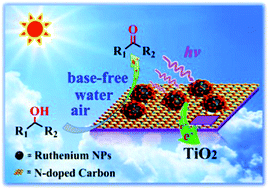当前位置:
X-MOL 学术
›
Energy Environ. Sci.
›
论文详情
Our official English website, www.x-mol.net, welcomes your feedback! (Note: you will need to create a separate account there.)
Dyadic promotion of photocatalytic aerobic oxidation via the Mott–Schottky effect enabled by nitrogen-doped carbon from imidazolium-based ionic polymers†
Energy & Environmental Science ( IF 32.5 ) Pub Date : 2018-12-11 00:00:00 , DOI: 10.1039/c8ee02727g Hong Zhong 1, 2, 3, 4, 5 , Can Yang 4, 5, 6, 7, 8 , Lizhou Fan 1, 2, 3, 4, 5 , Zhihua Fu 1, 2, 3, 4, 5 , Xue Yang 1, 2, 3, 4, 5 , Xinchen Wang 4, 5, 6, 7, 8 , Ruihu Wang 1, 2, 3, 4, 5
Energy & Environmental Science ( IF 32.5 ) Pub Date : 2018-12-11 00:00:00 , DOI: 10.1039/c8ee02727g Hong Zhong 1, 2, 3, 4, 5 , Can Yang 4, 5, 6, 7, 8 , Lizhou Fan 1, 2, 3, 4, 5 , Zhihua Fu 1, 2, 3, 4, 5 , Xue Yang 1, 2, 3, 4, 5 , Xinchen Wang 4, 5, 6, 7, 8 , Ruihu Wang 1, 2, 3, 4, 5
Affiliation

|
Metal/semiconductor systems are one type of promising heterogeneous photocatalyst for solar conversion. The injection of hot electrons from photoactivated metals to semiconductors is the rate-determining step owing to the Schottky barrier created at the interface. It is highly desirable to develop new approaches for promoting hot electron transfer. Herein, we present one type of new Mott–Schottky-type photocatalytic material consisting of TiO2 nanosheets and Ru nanoparticles (NPs) coated with nitrogen-doped carbon (TiO2@NC-Ru-T). They are readily available through the conformal coating of TiO2 with a main-chain imidazolium-based ionic polymer (ImIP), followed by anion exchange with perruthenate and subsequent pyrolysis; the sintering of Ru NPs is effectively inhibited by ImIP, generating small-sized and well-dispersed Ru NPs. The nitrogen-doped carbon in TiO2@NC-Ru-T both strengthens the performance of Ru NPs and facilitates photoelectron transfer from photoactivated Ru NPs to TiO2 through a Mott–Schottky contact. The dyadic effects greatly promote selective aerobic oxidation of alcohols with air as an oxidant under visible light irradiation. This work provides a feasible protocol for improving visible light absorption and charge/electron transfer in photocatalytic reactions, and holds great promise for developing a new type of solar-to-chemical energy conversion reaction.
中文翻译:

通过基于咪唑鎓离子聚合物的氮掺杂碳实现的Mott–Schottky效应, 二元促进光催化有氧氧化†
金属/半导体系统是一种有前途的用于太阳能转化的非均相光催化剂。由于在界面处产生了肖特基势垒,因此将热电子从光活化金属注入半导体是速率确定的步骤。迫切需要开发促进热电子转移的新方法。在这里,我们介绍一种新型的Mott-Schottky型光催化材料,它由TiO 2纳米片和涂有氮掺杂碳的Ru纳米颗粒(NPs)(TiO 2 @ NC-Ru-T)组成。它们可以通过TiO 2的保形涂层轻松获得用基于咪唑鎓盐的主链离子聚合物(ImIP),然后与过硼酸盐交换阴离子,然后进行热解;ImIP有效地抑制了Ru NP的烧结,生成了尺寸小且分散均匀的Ru NP。TiO 2 @ NC-Ru-T中的氮掺杂碳既增强了Ru NP的性能,又促进了光电子通过Mott–Schottky接触从光活化的Ru NP传递到TiO 2上。在可见光照射下,二元效应极大地促进了以空气为氧化剂的醇的选择性好氧氧化。这项工作为改善可见光吸收和光催化反应中的电荷/电子转移提供了可行的协议,并为开发新型的太阳能化学能转化反应具有广阔的前景。
更新日期:2018-12-11
中文翻译:

通过基于咪唑鎓离子聚合物的氮掺杂碳实现的Mott–Schottky效应, 二元促进光催化有氧氧化†
金属/半导体系统是一种有前途的用于太阳能转化的非均相光催化剂。由于在界面处产生了肖特基势垒,因此将热电子从光活化金属注入半导体是速率确定的步骤。迫切需要开发促进热电子转移的新方法。在这里,我们介绍一种新型的Mott-Schottky型光催化材料,它由TiO 2纳米片和涂有氮掺杂碳的Ru纳米颗粒(NPs)(TiO 2 @ NC-Ru-T)组成。它们可以通过TiO 2的保形涂层轻松获得用基于咪唑鎓盐的主链离子聚合物(ImIP),然后与过硼酸盐交换阴离子,然后进行热解;ImIP有效地抑制了Ru NP的烧结,生成了尺寸小且分散均匀的Ru NP。TiO 2 @ NC-Ru-T中的氮掺杂碳既增强了Ru NP的性能,又促进了光电子通过Mott–Schottky接触从光活化的Ru NP传递到TiO 2上。在可见光照射下,二元效应极大地促进了以空气为氧化剂的醇的选择性好氧氧化。这项工作为改善可见光吸收和光催化反应中的电荷/电子转移提供了可行的协议,并为开发新型的太阳能化学能转化反应具有广阔的前景。



























 京公网安备 11010802027423号
京公网安备 11010802027423号